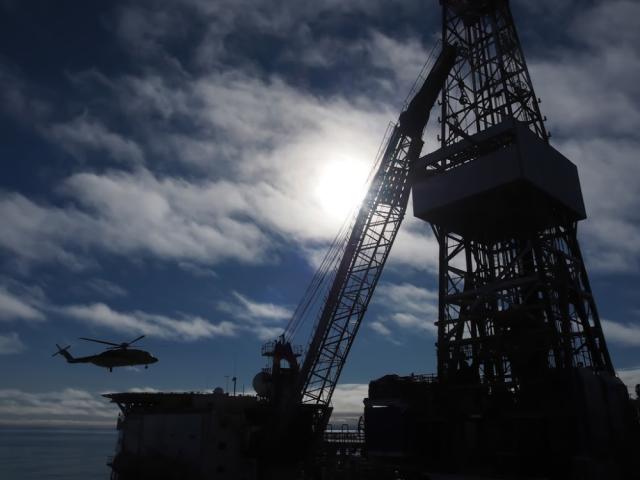
The U.S. Energy Information Administration forecasts oil production from new and existing fields in the GoM will rise to an average 2 MMbbl/d in 2020. (Source: Shutterstock.com)
SUGAR LAND, Texas—Finding the next barrel of oil in a mature basin that has already produced tens of billions of barrels of oil could be a daunting task, but oil and gas companies operating in the U.S. Gulf of Mexico (GoM) are doing just that with geological knowledge and seismic tools in hand.
“We’re looking for what we call exceptional reservoirs at unexceptional depths,” Barbara Lowery-Yilmaz, senior vice president of exploration for Hess Corp., told attendees of AAPG’s Global Super Basins Conference. That’s code, she added, for wells that make money and aren’t expensive or too complex to develop.
It’s part of the strategy behind the company’s offshore cash engine in the GoM, where Lowery-Yilmaz said Hess is focusing on the subsalt Miocene, Cretaceous and Norphlet plays. However, regardless of where a company opts to play, investment in seismic imaging is a must—whether it’s acquisition, processing algorithms, full-waveform inversion or computational speeds, she said, noting how these have helped the GoM reinvent itself through the years.
Exploration budgets were among the first to get chopped when oil and gas companies searched for ways to reduce spending as lower commodity prices hit profits. However, as market conditions improve, conventional exploration is getting investment needed to help meet the world’s growing energy needs.
The New York-headquartered company, which is one of Exxon Mobil Corp.’s partners on the oil- and gas-teeming Stabroek Block offshore Guyana and a top producer in the U.S. Bakken Shale, has set aside 15% of its $3 billion capex budget this year for exploration. That includes funds for seismic acquisition and processing in the Guyana-Suriname Basin and the GoM, where Hess has plans to test a frontier Cretaceous-age play in deep water. Recent work has included undertaking a large reprocessing effort in the Mississippi Canyon area.
She spoke of how the Cretaceous play has proven prolific onshore and work studying the transport of sediment from onshore into the GoM. For example, quartz-rich sediment has been deposited from the east part of Florida to the west. “There’s a well planned for later this year,” she said, adding it will take several wells to derisk the area.
That was the case with the Norphlet play, which is present onshore in Mississippi and Alabama and known for its HP/HT conditions offshore. Royal Dutch Shell Plc led the way in the play from onshore and eventually into deep water, where it made the Appomattox, Vicksburg A and Rydberg discoveries.
The GoM continues to reinvent itself, Lowery-Yilmaz said. She described the GoM as a well-established super basin with “26 billion barrels found to date, very large yet to find remain and big fields are still being found.”
A super basin is defined as a basin that has either produced at least 5 billion barrels of oil equivalent (Bboe) or has at least that much in recoverable reserves.
With an EUR of 200 Bboe, the GoM easily exceeds that, said John Snedden, director of the Institute for Geophysics’ Gulf Basin Depositional Synthesis Project. It has all the features characteristic of a super basin, he added, pointing out the GoM’s cumulative production of about 60 billion barrels, stacked reservoirs and well-established infrastructure that includes 52,000 wells and 7,000 platforms.
“I really think that the Gulf of Mexico basin is two or three super basins: one in the Gulf of Mexico, onshore and offshore,” Snedden said. “In Mexico itself, you could consider Sureste, Tampico-Misantla and Campeche to be separate super basins. So maybe this is a mega super basin.”
In terms of production, GoM wells have plenty to give compared to onshore shale wells.
Snedden compared a typical GoM well to a typical Austin Chalk producer: 11,000-15,000 barrels of oil per day (bbl/d) versus 300 bbl/d.
Most of the top-producing GoM wells, he said, are Plio-Miocene. Producing formations in the GoM, however, range from Pleistocene down to Jurassic-aged reservoirs. The newest producer is a Norphlet system.
“In terms of cumulative production per well…in the three protraction blocks—Green Canyon, Mississippi Canyon and Walker Ridge—the top 10 wells averaged anywhere from about 58 million barrels individually to 100 million barrels a year, producing something on the order of 14,000 barrels a day for 20 years to achieve that type of rate,” he said. “That is amazing. So what about that 300-barrel-day producer?”
The U.S. Energy Information Administration forecasts oil production from new and existing fields in the GoM will rise to an average 2 MMbbl/d in 2020, up from 1.9 MMbbl/d in 2019. The positive outlook comes as the offshore industry continues to bring down costs and improve breakevens by modifying designs, working closely with suppliers, taking phased development approaches and utilizing existing infrastructure.
Recommended Reading
NOV's AI, Edge Offerings Find Traction—Despite Crowded Field
2024-02-02 - NOV’s CEO Clay Williams is bullish on the company’s digital future, highlighting value-driven adoption of tech by customers.
Patterson-UTI Braces for Activity ‘Pause’ After E&P Consolidations
2024-02-19 - Patterson-UTI saw net income rebound from 2022 and CEO Andy Hendricks says the company is well positioned following a wave of E&P consolidations that may slow activity.
SM Energy Adds Brookman to Board, Promotes Lebeck to Executive VP
2024-02-23 - Barton R. Brookman previously served as President and CEO of PDC Energy and James B. Lebeck served as senior vice president and general counsel since January 2023.
Crescent Point Energy to Rebrand as Veren Inc.
2024-03-21 - The company will seek shareholder approval for the change at its upcoming annual and special meeting of shareholders on May 10.
From Restructuring to Reinvention, Weatherford Upbeat on Upcycle
2024-02-11 - Weatherford CEO Girish Saligram charts course for growth as the company looks to enter the third year of what appears to be a long upcycle.






